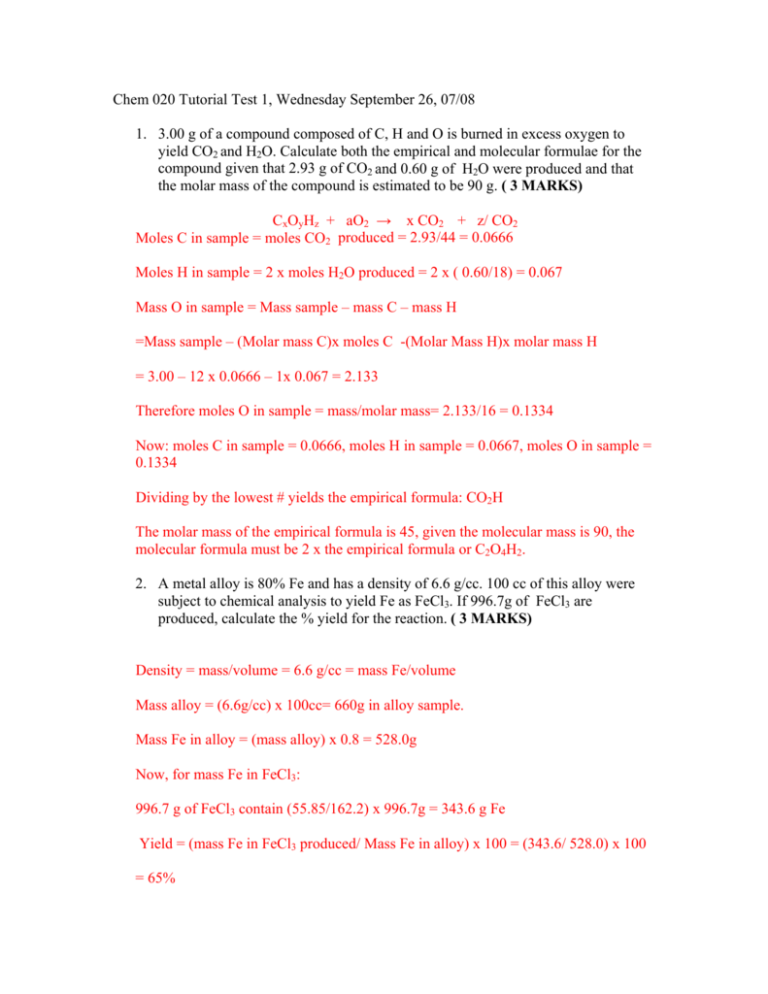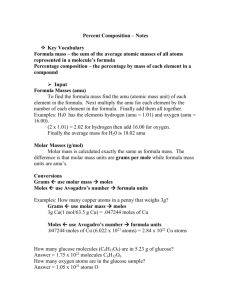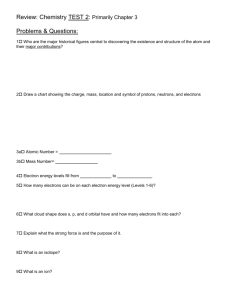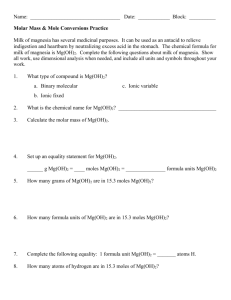Chem 020 Tutorial Test 1, Wednesday September 26, 07/08 1. 3.00
advertisement

Chem 020 Tutorial Test 1, Wednesday September 26, 07/08 1. 3.00 g of a compound composed of C, H and O is burned in excess oxygen to yield CO2 and H2O. Calculate both the empirical and molecular formulae for the compound given that 2.93 g of CO2 and 0.60 g of H2O were produced and that the molar mass of the compound is estimated to be 90 g. ( 3 MARKS) CxOyHz + aO2 → x CO2 + z/ CO2 Moles C in sample = moles CO2 produced = 2.93/44 = 0.0666 Moles H in sample = 2 x moles H2O produced = 2 x ( 0.60/18) = 0.067 Mass O in sample = Mass sample – mass C – mass H =Mass sample – (Molar mass C)x moles C -(Molar Mass H)x molar mass H = 3.00 – 12 x 0.0666 – 1x 0.067 = 2.133 Therefore moles O in sample = mass/molar mass= 2.133/16 = 0.1334 Now: moles C in sample = 0.0666, moles H in sample = 0.0667, moles O in sample = 0.1334 Dividing by the lowest # yields the empirical formula: CO2H The molar mass of the empirical formula is 45, given the molecular mass is 90, the molecular formula must be 2 x the empirical formula or C2O4H2. 2. A metal alloy is 80% Fe and has a density of 6.6 g/cc. 100 cc of this alloy were subject to chemical analysis to yield Fe as FeCl3. If 996.7g of FeCl3 are produced, calculate the % yield for the reaction. ( 3 MARKS) Density = mass/volume = 6.6 g/cc = mass Fe/volume Mass alloy = (6.6g/cc) x 100cc= 660g in alloy sample. Mass Fe in alloy = (mass alloy) x 0.8 = 528.0g Now, for mass Fe in FeCl3: 996.7 g of FeCl3 contain (55.85/162.2) x 996.7g = 343.6 g Fe Yield = (mass Fe in FeCl3 produced/ Mass Fe in alloy) x 100 = (343.6/ 528.0) x 100 = 65% 3. NO is produced by the following process: 4 NH3 + 5 O2 → 4 NO + 6 H2O What is the maximum mass of H2O that could be obtained from reacting 60 g of NH3 with 150 g O2? ( 2 MARKS) Moles NH3 = (Mass/molar mass) = 60/17 = 3.53 Moles O2 required = (5/4) x 3.53 = 4.41 Moles O2 available = 150/32 = 4.69 NH3 is limiting and moles H2O produced = (6/4) x Moles NH3 = (6/4) x 3.53 = 5.295 Mass H2O produced = 18 x 5.295 = 95.3 g 4. There are three stable isotopes of oxygen: 16O mass = 15.999 amu, abundance = 99.76%; 17O mass = 16.999 amu, abundance = 0.04%; 18O mass = 17.999 amu, abundance = 0.2%. What would the average atomic mass be for O if the abundance of all three isotopes were equal? ( 2 MARKS) Assume any equal # of atoms of each isotope, say 300. Then # 16O atoms = 17O atoms = 18O atoms = 100 Average mass = (total mass)/(total # of atoms) Mass 100 16O atoms = 100 x 15.999 amu = 1599.9 amu Mass 100 17O atoms = 100 x 16.999 amu = 1699.9 amu Mass 100 18O atoms = 100 x 17.999 amu = 1799.9 amu Total mass for all 300 O atoms = 5099.7 amu Average mass = 5099.7 amu/300 = 16.999 amu Chem 020 Tutorial Test 1, Tuesday, October2, + Wednesday Oct 32007 1. 3.00 g of a compound composed of C, H and O is burned in excess oxygen to yield CO2 and H2O. Calculate both the empirical and molecular formulae for the compound given that 7.76 g of CO2 and 1.59 g of H2O were produced and that the molar mass of the compound is estimated to be 136 g. CxOyHz + aO2 → x CO2 + z/ CO2 Moles C in sample = moles CO2 produced = 7.765/44 = 0.1765 Moles H in sample = 2 x moles H2O produced = 2 x (1.59/18) = 0.1767 Mass O in sample = Mass sample – mass C – mass H =Mass sample – (Molar mass C)x moles C -(Molar Mass H)x molar mass H = 3.00 – 12 x 0.1765 – 1x 0.1767 = 0.7053 Therefore moles O in sample = mass/molar mass= 0.7053/16 = 0.0.0441 Now: moles C in sample = 0.1765, moles H in sample = 0.1767, moles O in sample = 0.0441 Dividing by the lowest # yields the empirical formula: C4OH4 The molar mass of the empirical formula is 68, given the molecular mass is 136, the molecular formula must be 2 x the empirical formula or C8O2H8. 2. A metal alloy is 85 % Fe and has a density of 7.6 g/cc. 100 cc of this alloy were subject to chemical analysis to yield Fe as FeCl3. If 996.7g of FeCl3 are produced, calculate the % yield for the reaction. Density = mass/volume = 7.6 g/cc = mass Fe/volume Mass alloy = (7.6g/cc) x 100cc= 760g in alloy sample. Mass Fe in alloy = (mass alloy) x 0.85 = .85 x 760 = 646.0g Now, for mass Fe in FeCl3: 996.7 g of FeCl3 contain (55.85/162.2) x 996.7g = 343.6 g Fe Yield = (mass Fe in FeCl3 produced/ Mass Fe in alloy) x 100 = (343.6/ 646.0) x 100 = 53 % 3. NO is produced by the following process: 4 NH3 + 5 O2 → 4 NO + 6 H2O What is the maximum mass of H2O that could be obtained from reacting 60 g of NH3 with 150 g O2? Moles NH3 = (Mass/molar mass) = 60/17 = 3.53 Moles O2 required = (5/4) x 3.53 = 4.41 Moles O2 available = 150/32 = 4.69 NH3 is limiting and moles H2O produced = (6/4) x Moles NH3 = (6/4) x 3.53 = 5.295 Mass H2O produced = 18 x 5.295 = 95.3 g 4. There are three stable isotopes of oxygen: 16O mass = 15.999 amu, abundance = 99.76%; 17O mass = 16.999 amu, abundance = 0.04%; 18O mass = 17.999 amu, abundance = 0.2%. What would the average atomic mass be for O if the abundance of all three isotopes were equal? Assume any equal # of atoms of each isotope, say 300. Then # 16O atoms = 17O atoms = 18O atoms = 100 Average mass = (total mass)/(total # of atoms) Mass 100 16O atoms = 100 x 15.999 amu = 1599.9 amu Mass 100 17O atoms = 100 x 16.999 amu = 1699.9 amu Mass 100 18O atoms = 100 x 17.999 amu = 1799.9 amu Total mass for all 300 O atoms = 16.00339 amu Average mass = 5099.7 amu/300 = 16.999 amu Chem 020 Tutorial Test 1, September 24 and 25, 07/08 1. 3.00 g of a compound composed of C, H and O is burned in excess oxygen to yield CO2 and H2O. Calculate both the empirical and molecular formulae for the compound given that 7.20 g of CO2 and 1.47 g of H2O were produced and that the molar mass of the compound is estimated to be 110 g. CxOyHz + aO2 → x CO2 + z/ CO2 Moles C in sample = moles CO2 produced = 7.2/44 = 0.1636 Moles H in sample = 2 x moles H2O produced = 2 x ( 1.47/18) = 0.1636 Mass O in sample = Mass sample – mass C – mass H =Mass sample – (Molar mass C) x moles C -(Molar Mass H)x molar mass H = 3.00 – 12 x 0.1636 – 1x 0.1636 = 0.8732 Therefore moles O in sample = mass/molar mass= 0.955/16 = 0.0546 Now: moles C in sample = 0.1636, moles H in sample = 0.1636, moles O in sample = 0.0546 Dividing by the lowest # yields the empirical formula: C3OH3 The molar mass of the empirical formula is 55, given the molecular mass is 110, the molecular formula must be 2 x the empirical formula or C6O2H6. 2. A metal alloy is 80% Fe and has a density of 6.6 g/cc. 100 cc of this alloy were subject to chemical analysis to yield Fe as Fe(NO3)3. If 796.7g of Fe(NO3)3 are produced, calculate the % yield for the reaction. Density = mass/volume = 6.6 g/cc = mass alloy/volume Mass alloy = (6.6g/cc) x 100cc= 660g Mass Fe = 0.8 x 660 = 528 g 796.7 g of Fe(NO3)3 contain (55.85/241.85) x 796.7g = 183.98 g Fe But mass Fe expected = 528 g % yield Fe = (mass Fe in product/Mass Fe in alloy) x 100 = (183.98/528) x 100 = 34.8 % 3. NO is produced by the following process: 4 NH3 + 5 O2 → 4 NO + 6 H2O What is the maximum mass of H2O that could be obtained from reacting 60 g of NH3 with 150 g O2? Moles NH3 = (Mass/molar mass) = 60/17 = 3.53 Moles O2 required = (5/4) x 3.53 = 4.41 Moles O2 available = 150/32 = 4.69 NH3 is limiting and moles H2O produced = (6/4) x Moles NH3 = (6/4) x 3.53 = 5.295 Mass H2O produced = 18 x 5.295 = 95.3 g 4. There are three stable isotopes of oxygen: 16O mass = 15.999 amu, abundance = 99.76%; 17O mass = 16.999 amu, abundance = 0.04%; 18O mass = 17.999 amu, abundance = 0.2%. What would the average atomic mass be for O if the abundance of the three isotopes were 20% 16O, 30% 17O and 50% 18O? Assume any total # of O atoms, say 100. Average mass = (total mass)/(total # of atoms) # of 16O atoms = 20 Mass 20 16O atoms = 20 x 15.999 amu = 319.98 amu # of 17 O atoms =30 Mass 30 17O atoms = 30 x 16.999 amu = 509.97 amu # of 18 O atoms = 50 Mass 50 18O atoms = 50 x 17.999 amu = 899.95 amu Total mass for all 100 O atoms = 1729.9 amu Average mass = 1729.9 amu/100 = 17.299 amu Strong acids/bases





